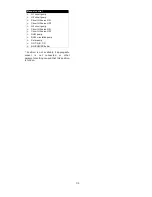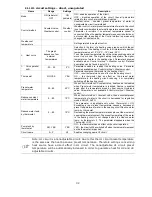
17
to this the boiler will not heat up the DHW
tank. Similar effect can be obtained by setting
the work mode for DHW tank to
Off
manually.
Loading DHW tank can be also optimized by
setting a lowest possible preset temperature
of DHW tank. The lower preset temperature of
HUW tank, the less often boiler will become
active in order to load the tank and solar
energy gain will be higher.
Installer from a service level should set the
highest possible DHW tank maximum
temperature. This will generate the maximum
heat gain. On the other hand there is a risk of
scalding with hot water and exceeding
temperature limit for a particular DHW tank!
Risk of scalding with DHW!
In order to protect against
scalding, install an additional
protective
automatics,
e.g.
thermostatic mixing valve.
During periods of very high insolation, there
can be a situation in which the HUW tank is
not able to absorb big amount of heat. In such
case, a solar pump transporting heat from a
solar panel to HUW tank becomes off. Due to
a risk of damaging the pump, it is turned off
only when the solar panel temperature drops.
In practice, the solar system is turned on
again the next day after the sunrise. It
indicates a normal operation resulting from
the fact that there is no possibility of
absorbing the heat surplus.
Weather control
In order for the room temperature to be
stable, must be set the weather control. The
weather control must be activated separately
for each heating circuit. The weather control
is influenced by the setting of the heating
curve and the curve parallel shift.
The heating circuit water preset temperature
is calculated basing on the temperature
prevailing outside the building. The colder it is
outside, the higher water temperature in the
heating circuit is. This relation is shown in the
controller in the form of heating curve.
The heating curve can be changed in a graph
from the system menu, within the range for
the weather preset temperature. It is a
reflection of the thermal characteristics of the
building. If the building is less insulated then
the heating curve should be greater.
Setting the heating curve: Tp
–
temperature preset by
weather, Tz
–
exterlan temperature.
Heating
curve
should
be
selected
experimentally by changing it in a few day
intervals.
During trial and error selection of
appropriate heating curve, it is
necessary to exclude influence of
the thermostat on regulator
operation (regardless of whether
the thermostat is connected or
not), by setting the parameter
Thermostat
=
OFF
for each heating
circuit.
After choosing the proper heating curve, the
circuit preset temperature
is calculated
according to the outside temperature. As a
result if the heating curve is appropriate for
the building, the room temperature remains
constant regardless of the temperature
outside.
Guidelines for selecting a proper heating
curve:
- if at dropping external temperature, room
temperature increases, the selected heating
curve is too high,
- if at dropping external temperature, room
temperature also drops, the selected heating
curve is too low,
Poorly warmed buildings require setting
higher heating curves. Whereas for well
heating buildings, heating curve will have a
smaller value.
The range of the heating curve is limited by
the minimum and maximum preset water
temperature.
Thermostat settings
In order for the room temperature to be
stable, the thermostat should be activated.
The thermostat complements the weather
















































